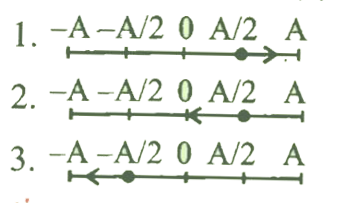For a particle in SHM find phase difference between situations (a) 1 & 2 (b) 1 & 3

(a) 2π/3
(b) 7π/6
Phase difference Δθ=2πT×Δt
Topper's Solved these Questions
- BOOK - NARAYNACHAPTER - OSCILLATIONSEXERCISE - EVALUATE YOURSELF - 17videos
OSCILLATIONS
- BOOK - NARAYNACHAPTER - OSCILLATIONSEXERCISE - EVALUATE YOURSELF - 24videos
OSCILLATIONS
- BOOK - NARAYNACHAPTER - OSCILLATIONSEXERCISE - DAMPED OSCILLATIONS1videos
OSCILLATIONS
- BOOK - NARAYNACHAPTER - NEWTONS LAWS OF MOTIONEXERCISE - PASSAGE TYPE QUESTION6videos
NEWTONS LAWS OF MOTION
- BOOK - NARAYNACHAPTER - PHYSICAL WORLDEXERCISE - C.U.Q10videos
PHYSICAL WORLD
Similar Questions
Knowledge Check
- Question 1 - Select One
The period of SHM of a particle is 12 s. The phase difference between the positions at t = 3 s and t = 4 s will be
Aπ/4B3π/5Cπ/6Dπ/2 - Question 2 - Select One
A particle executing SHM. The phase difference between velocity and displacement is
A0Bπ2CπD2π - Question 3 - Select One
A particle executing SHM. The phase difference between acceleration and displacement is
A0Bπ2CπD2π
Find the phase difference between voltage and current.
View SolutionFind the phase difference between voltage and current.
View Solution(a) A particle is subjected to two SHMs of same time period in the same direction. If A1=6cm, A2=8cm, find the resultant amplitude if the phase difference between the motions is (a) 0∘, (b) 60∘, (c) 90∘ and (d) 120∘.
(b) In the previous problem if A1=A2=a and resultant amplitude is also a, find phase difference between them.
(c) Three SHMs of equal amplitude A and equal time periods in the same direction combine. The phase of the second motion is 120∘ ahead of first and the phase of the third motion is 120∘ ahead of the second. Find the amplitude of the resultant motion.View SolutionTwo particles P and Q describe S.H.M. of same amplitude a, same frequency f along the same straight line from the same mean position. The maximum distance between the two particles is a √2, If the initial phase difference between the particles is πN then find N :
View SolutionA particle is executing SHM of amplitude A, about the mean position X = 0. Which of the following cannot be a possible phase difference between the positions of the particle at x = + A/2 and x = A/√2
View Solution

